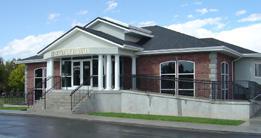
25 minute read
History of Sanpete County
Where in the world did Sanpete County get its name? It all started when the Ute Chief Wakara invited pioneers to settle the San Pitch valley, named after a tribe of hunter-gatherer Indians.
Wakara claimed that the Great Spirit had appeared to him in a dream, telling him to welcome the white men. Later, Wakara engaged his guests in the infamous “Walker War” from 1853-54. The Black Hawk War, named for another Ute leader, also disrupted county settlement from 1865-68.
Advertisement
Eventually, the San Pitch name was corrupted to Sanpete. Some historians now believe that more than the agricultural skills Wakara claimed to want for himself and his tribe, he was interested in the cattle that the pioneers seemed to take with them everywhere they went.
The county wasn’t the only entity to undergo a name change. Most of the cities within the county have gone through changes in identity since their founding. Sanpete County is the home of several towns. How they originated and came to be can be an interesting story. The following stories are shortened versions of some of Sanpete’s best-known towns.
MT. PLEASANT
Mt. Pleasant is known for its 19th-century Main Street buildings, for being home to Wasatch Academy, and for being the largest city in the northern half of the county. As of the 2010 census, the city population was 3,260.
After taking lumber out of Pleasant Creek Canyon in late 1851, a band of Mormon colonists from Manti led by Madison D. Hambleton returned in the spring of 1852 to establish the Hambleton Settlement near the present site of Mt. Pleasant. During the Wakara War, the small group of settlers relocated to Spring Town and later to Manti for protection. The old settlement was burned down by local Native Americans, so when a large colonizing party from Ephraim and Manti returned to the area in 1859, a new, permanent town site was laid out in its present location.
Among the founding settlers were members of The Church of Jesus Christ of Latter- day Saints, also known as Mormon converts, from Scandinavia, the United Kingdom and the eastern United States. By 1880, Mt. Pleasant was the county’s largest city with a population of 2,000. More than 72 percent of its married adults were foreign born.
This ethnic diversity had an important impact on village life during the 19th and early 20th centuries. For decades, five languages were commonly spoken in town, creating confusing and sometimes amusing communication problems.
The settlement and development of Mt. Pleasant followed the typical pattern for Mormon towns of the period. A squareshaped town site was surveyed, eventually containing about 100 city blocks. Lots were drawn and the land was distributed among the population.
Under the direction of James Russell Ivie (1802–1866), a fort of adobe walls and log cabins was built. Pleasant Creek ran through the fort and farming was done outside of its walls.
Around the time that Ivie was killed in the Blackhawk War by Indians who had declined to participate in the settlement of the earlier Wakara War, the town had acquired its present name. By the time the final peace treaty with the Indians was signed in Bishop Seeley’s house on Mt. Pleasant Main Street in 1872, bringing to an end to this conflict, many settlers had already erected homesteads outside of the fort.
Although the town site is large in scale, the density is relatively low due to the original layout allowing for only four lots per block.
The influence of members of The Church of Jesus Christ of Latter-day Saints was felt in all religious, political, economic, educational and social aspects of life in early Mt. Pleasant. Self-sufficiency was a virtue and home-grown and home-manufactured food, clothing and furnishings were far more available than rarely found imported items. Some of the first industries included hide tanning, shoemaking, blacksmithing, basket-making and freighting.
Eventual modernization brought such improvements as the Deseret Telegraph in 1869, The Pyramid newspaper in 1890 and a telephone system in 1891. Sawmills and flour mills were built, irrigation systems were dug and a municipal government was created to oversee public laws and improvements.
The city was incorporated in 1868, a year after the first cooperative store was founded, starting what became a burgeoning commercial district. Upon the arrival of the Rio Grande Western Railway in 1890, both the local population and the city’s prosperity increased dramatically. By 1900, Mt. Pleasant had grown to nearly 3,000 persons, the largest size reached by any city in Sanpete County to that time, and the city had earned one of its nicknames, “Hub City.”
The town’s new-found wealth became immediately apparent in a building boom which saw the replacement of small, wood-frame commercial buildings with much more impressive, architect-designed stone and brick structures such as the 1888 Sanpete County Co-op, the Gentile store that competed with the ZCMI, or Mormon, store. The resulting Main Street district is so architecturally distinctive that the two-block-long area has been listed on the National Register of Historic Places.
Equally striking are the Victorian churches, schools, and residences which replaced the simpler adobe and log buildings of the pioneer period. Mt. Pleasant has long been considered the most diverse city in the county, in part because of the liberal Mormons and the Protestant groups that challenged the dominant Mormon population in the late 19th century.
Liberal Hall, built on Main Street in 1875, and Wasatch Academy, Utah’s oldest surviving private boarding school established by Presbyterians in the same year, remain as visible and functional testaments of the city’s historic and ongoing diversity.
The 20th century brought continued changes and improvements to the face of the “Queen City,” its most popular nickname. The commercial and residential districts continued to fill with fine buildings bespeaking the prosperity of the community.
By 1912, the first high school, North Sanpete High School, had been completed. The year 1912 also brought the Armory Hall, while the Elite Theater was constructed as a “fireproof” building in 1913. It burned down seven decades later.
In 1917, a fine Carnegie Library was built in a modern architectural style. The Marie Hotel was erected in 1920 and a large cheese factory came on the scene in 1930, the same year that bus service came to town. The completion of U.S. Highway 89 in 1936 was a boon needed to soften the impact of the Great Depression. A city hall in 1939 and hospital in 1945, together with new schools and churches, gave Mt. Pleasant a full complement of public buildings.

Ephraim, the largest town in Sanpete County, was founded by a lone settler, Isaac Behunin, who claimed 40 acres on Pine Creek. Because of Indian troubles, he and his family has to abandon their homestead and move to the Manti Fort in 1853.
When it was deemed safe to return in 1854, Behunin found that he was no longer alone. Several families tagged along and built homes in the place they called Cottonwood Creek. Because of the unpredictable temperament of the Indians, they soon put up a fort approximately a square block in size and the settlement was called Fort Ephraim, getting its name from one of the tribes of Israel mentioned in the Old Testament. The security of the fort drew a diverse group of settlers to the area, including Danes, Swedes and Norwegians. When the Danes moved in, they called it “Little Denmark.” Yet once “Fort” was dropped, the name Ephraim stuck.

INDIANOLA
Located on the northeast edge of Thistle Valley, Indianola was organized as a ward and named by Apostle Erastus Snow in 1880. Then it numbered over 100 members — half Indians, half Whites. North Sanpeters had herded livestock in the valley and even homesteaded there before Brigham Young decided to set up a model Indian farm for Utes not already removed to the Unitah Basin. Eventually, the church had to pay $12,000 to induce pioneers to vacate the valley.
Eventually, most of the Utes moved away, died or simply failed to multiply, so some of the sellers eventually returned to the valley. Most of them lived on their farms rather than locate close to the brick meetinghouse (now a granary) built on the town site. Some years later, in about 2007, a new church meeting house was built to serve the community.
MILBURN
Milburn occupies a picturesque cove barely visible from the U.S. 89 scenic overlook near Hilltop. Platted in 1886 on a rocky slope watered by Dry Creek, it was organized as a ward in 1896. The fair number of sawmills already built in canyons above it sparked the choice of name. Families began homesteading this herd ground of Fairview as early as 1876, so a majority of Milburners never lived in the town itself, which was loosely clustered around a school, church and stone store/dance hall whose walls still stand.
When Dry Creek turned wet and wiped out the town in 1903, the population spread out even more. Eventually, so many moved away that the church dissolved the ward and transferred the last 33 members to Fairview in 1961.

FREEDOM
Freedom was settled in 1875 under the name of Draper, which was the name of the families who settled there. The settlement was located along Current Creek south of Fountain Green and north of Wales. In 1877, the Drapers and other families formed a ward which was renamed Freedom and lasted until 1881.
The arrival of the Martin Van Buren Taylor family eventually required the creation of a new ward in 1897 which lasted until 1926. The orchards, the best in Sanpete, and the Meadow View Creamery kept the small community going. Freedom is the gateway to beautiful Maple Canyon.
Soon after homesteading fever hit Sanpete in 1870, polygamists and other farmers from Mt. Pleasant, Moroni and Spring City spread out onto the meadows along the bottomlands of Oak and Canal Creeks below Spring City.
Despite their dispersion, they formed a ward in 1877 named Chester, shortened by the Post Office from the “Chesterfield” proposed by David Candland who had immigrated from Chesterfield, England.
We must forgive Candland’s lack of originality. He was only trying to improve the image of the hamlet from its original name: The Bottoms. A meetinghouse, a school, an Allred store and a few houses soon sprang up close to the crossroads at the center of town.

WALES
The small mining town of Wales was named for the country of the immigrants who were sent there by Brigham Young in 1859 to mine the “rock that burns.” An Indian named Tabiyuna, a prominent Ute, had showed Young a small sample. Young knew it was coal and asked if any of his group knew how to mine the coal. The immigrants were sent to the west side hills to set up mines.
The community’s original name was Coal Bed, but it was changed to Wales in 1869. There once was a railroad depot, and it was an important and busy mining center. The mines and town were abandoned when more productive mines were discovered in Scofield. Many of the present residents are descendants of the original miners.
A four-wheel drive road up Wales Canyon leads to open meadows on the top and a dirt road travels down the other side to Chicken Creek Campground and into Levan.
Tom A Dyches Insurance Agency & Appraisal Services have been serving the county for over 40 years and offers insurance and appraisal services including auto/home life insurance & health insurance including Medicare supplements. Bond/commercial policies, we write them all. We are a full service agency and will take care of your insurance needs as well as single family home appraisals in four counties. Call us first. Home • Auto • Life • Health What types of risks does your insurance policy cover? Find out with a free review and rate quote. We offer expansive coverage and affordable premiums to put peace of mind in your reach. What If? Home ▪ Auto ▪ Life ▪ Health Tom A Dyches Insurance Agency & Appraisal Services have been serving the county for over 40 years and offers insurance and appraisal services including auto/home life insurance & health insurance including Medicare supplements. Bond/commercial policies, we write them all. We are a full service agency and will take care of your insurance needs as well as single family home appraisals in four counties. Call us first. What types of risks does your insurance policy cover? Find out with a free review and rate quote. We offer expansive coverage and affordable premiums to put peace of mind in your reach. What If? 590 So State, Mt. Pleasant (435) 462-2844 (435) 469-0113 TOM DYCHES Insurance & Realty Dyches Real ty★590 So State, Mt. Pleasant (435) 462-2844 (435) 469-0113 Your Independent Insurance Agent Tom Dyches Insurance & Realty 590 So State, Mt. Pleasant (435) 462-2844 Home • Auto • Life • Health TOM DYCHES Insurance & Realty Dyches Real ty★590 So State, Mt. Pleasant (435) 462-2844 Home ▪ Auto ▪ Life ▪ Health Tom Dyches Insurance & Realty (435) 469-0113(435) 469-0113 Your Independent Insurance Agent
Centerfield was first known as Skin Town. It seems that in about 1880, a new method for tanning cowhides was discovered and implemented in New York. At the same time, Sanpete suffered a terrible winter with such deep snow that many cattle couldn’t find enough forage and died.
In order to keep their operations from being a total loss, the ranchers skinned the cows, used the new tanning method on the hides and hung them out on their fences to dry. The fact that all the fences were draped with cow hides led to the name “Skin Town.” It was also called South Gunnison or Twin Town. When the town was incorporated in 1907, the residents chose the more dignified name of Centerfield because of the community’s central location.
Centerfield is an 1860s offshoot of Gunnison that evolved two miles south on US 89. Gunnison Field or Gunnison South was a natural site for farmers who worked small “squatters rights” plots of about five acres with oxen and hand plows.
After the Indian troubles subsided, log and adobe houses began to appear. A late 1876 petition to “build a school convenient to our location” was an early sign of independence from the mother colony.
In 1882, a log cabin was built to serve as school, church and social hall. The 1886-87 church was built of stone and a front tower was added in 1897. Community spirit was strong by that time, and Canute Peterson chose a committee of four who named the place for its location in the fields between Gunnison and Axtell.
Axtell was settled about 1874 by John Bosshardt, who raised the first barley and alfalfa; Lars Fjeldsted, who ran a co-op herd of sheep; and Axel Finarsen, a Danish bachelor. The town spread out on an east-west axis along Willow Creek, which was the area’s name until the arrival of the railroad and post office in 1891.
The place has an expansive open flavor reminiscent of the Midwest with irrigated grains and alfalfa sweeping eastward to the foothills of the Wasatch Plateau.
Farms and houses are dispersed, as are Axtell’s “central places,” notably the post office and the ward house. Thus, it differs from the typical Mormon village settlement plan.
Axtellers have a keen appreciation of their “peace and quiet” and a sense of “in between” stemming from their county border location. Notable sites include historic and contemporary salt mines in the foothills to the east and west. Willow Creek Reservoir, a haven for wildlife, is about 5.5 miles east of town behind the foothills, and a graded road continues to the Skyline Drive near 10,984 foot Musinia Peak.

FAYETTE
Fayette was settled by five families from Springville who arrived by ox team on April 8, 1861. After finding Hog Wallow (Gunnison) too crowded, they backtracked five miles to establish Warm Creek. Three families soon left, but the Joseph Bartholomew and James Mellor families stuck it out and descendants remain today.
One pioneer described the site as a lush meadow paradise abounding in wildlife. Chief Arapeen extracted two fat oxen for ceding the life-giving spring and some calves for the meadowlands. Willow-covered dugouts and wagon boxes




first provided shelter, followed by log cabins and later houses of local stone and brick.
Retreats were common and log buildings were moved inside the Gunnison fort during the Blackhawk War of the 1860s. Apostle Orson Hyde urged the name change to Fayette for the New York town where The Church of Jesus Christ of Latter-day Saints was organized.

FAIRVIEW
Founded in 1859, the town’s high elevation provided a fair enough view of the valley to inspire the choice of name in 1864. The first settlers from Mt. Pleasant had named the site North Bend.
Fairview became the center of a wealthy agricultural district which in 1900 supported four general stores, one furniture store, one harness shop, two hotels, one butcher shop, a planing mill, half a dozen steam sawmills situated at different points in the mountains, good public schools and a great number of comfortable homes.
The town is home to the Fairview Museum of History and Art, which is full of historical data, artifacts, pictures and artwork, and a full-scale replica of a nearly fully intact Columbian mammoth that was unearthed on the nearby Wasatch Plateau in 1988 during excavation of Huntington Reservoir. The quality of the find, plus the altitude at which it was found, make this mammoth unique.
Fairview Canyon is a great place to ride ATVs and mountain bikes as well as to fish, hunt, horseback ride, camp, snowkite and snowmobile. Fairview is the gateway to the famous Skyline Drive, a 75-mile scenic 4x4 mountain road that offers hundreds of miles of outdoor recreational opportunities.
Numerous trout-filled ponds, lakes and streams can be found along the Skyline Drive. Huntington Reservoir boasts a large tiger trout population. The Huntington-Eccles Scenic Byway also begins in Fairview. The drive heads east up the canyon on Highway 31 through the Manti La-Sal National Forest.
SPRING CITY
In 1852, James Allred and his sons were sent from Manti to settle in Canal Creek. With so many Allreds in the area, it isn’t surprising that the first name was Allred Settlement.
With the outbreak of the ~` War hostilities in July of 1853, Hambleton settlers on Pleasant Creek retreated to the Allred Settlement and pleas for reinforcements brought 50 Danish families via Salt Lake. The village was sacked, and settlers removed to Manti and soon helped establish Fort Ephraim. When they finally returned in 1859, the agreed on the name Spring City. It’s an appropriate name, since the spring in the center of town always runs. The city is on the National Register of Historic Places. Spring City was highlighted on Forbes. com’s list of America’s Prettiest Towns in 2010.
FOUNTAIN GREEN
Fountain Green is just east of Salt Creek Canyon and east of Nephi. It began as a popular campground for Salt Creek and San Pitch travelers during the 1850’s before the Johnsons and other families from Santaquin in Utah Valley settled it. Lying just below the Divide and Mt. Nebo, it had a green fountain named “Big Springs,” which was second to no other spring in the Sanpete Valley.
In 1849, as groups of Mormon colonists began to immigrate to the fertile Sanpete Valley, many of them camped at a verdant location in the northwestern end of the valley known as


Uintah Springs. A decade later, George W. Johnson, Santaquin, was granted permission to establish a permanent settlement on the popular campgrounds.
In July 1859, Albert Petty surveyed a town site, laying out 20 blocks of about 4.5 acres each. Other pioneers soon joined the Johnson family, building log homes and, in 1860, a multipurpose log meetinghouse. In the same year, an irrigation channel was plowed to a canyon in the San Pitch Mountains just west of town, and the growth of Fountain Green was well under way.
Fountain Green’s name is still a fitting description of the lush, green hillside village abundantly watered by what is now called Big Springs and Silver Creek, which it forms. Artesian wells and, later, pumped water provided an ample water supply, allowing the development of agriculture and stock raising, the staple industries of the town from 1860 to the present.
In 1865, a sawmill was constructed, followed in 1866 by an adobe meetinghouse and, in 1867, a flour mill. Due to hostilities and one death during the Black Hawk War of 1865-67, a rock fort was erected in 1866. After peace was made with the San Pitch Indians, growth and progress continued unhindered and major crops of wheat, oats and potatoes were harvested.
Although Fountain Green was the first Sanpete community to receive the railroad in the 1880s, it did not take full advantage of this opportunity, being the only major town in the region to drop in population between 1880 and 1890. Experiencing less fluctuation in size than most other Sanpete villages, Fountain Green reached its zenith of about 1,150 people in 1920, about twice its size of 578 in 1980. Its current population is estimated at just under 1,000.
Fountain Green’s flourishing in the early 20th century, during which time it was considered the “richest town” in the county, was due mostly to its successful wool-growing industry. Expanding from a cooperatively owned herd of Spanish Merino sheep in the 1880s, sheep growers greatly enhanced their profits after upgrading their herds with high-wool-producing Rambouillet stock.
In 1902, 40,850 sheep were owned by 26 growers for an average of 1,571 head of sheep each, although some owned far more than others. The Fountain Green Woolgrowers Association was founded in 1908 and became the dominant group in town, with the possible exception of The Church of Jesus Christ of Latter-day Saints, whose members they shared in common.
The association created the nationally famous Jericho Pool of 100,000 sheep, giving Fountain Green its nickname of “Wool City.” A celebration known as the “City of Lambs Days” is still held annually, although the sheep industry has diminished in importance over the years.
In 1987, 47 percent of the farms in northwest Sanpete County raised turkeys, while only 26 percent produced sheep, revealing the economic shift from Fountain Green to Moroni, the center of the county’s turkey industry.

GUNNISON
The establishment of Gunnison in 1862 resulted from the resettlement and merging of two earlier communities, each built in 1859 along the lower San Pitch River in upper Gunnison Valley.
A group of settlers from Sanpete County had started a village on the south bank of the river at Chalk Hill Point about two miles east of the eventual town. At about the same time, a group of colonists from Springville and other places formed a settlement about three miles west of Chalk Hill. They called


the place Kearns Camp after their leader, Mormon Bishop H.H. Kearns.
Simple houses were erected at each location with the intention of creating permanent communities. The impetus for settlement in the area had come from Brigham Young after his tour from Manti to the Sevier Valley and the southern colonies in May 1850.
During a return visit in 1862, Young saw the limitations of the swampy area, which was termed “too muddy for a hog’s wallow.” He advised the people to move up to the bench area, where a new town was built.
The town was named in honor of government explorer Captain John Gunnison, who was killed with six of his men by Indians while in the Sevier Valley area in 1853. Edward Fox surveyed the town site in rectangular 8-acre blocks and James Mellet erected the first house as the pioneers dismantled and carted their earlier structures to the new site in late 1862.
They were now a long distance from water, so the first public task was to dig a ditch from the river to the bench-top town. Early settlement efforts were hampered by difficulties with Indians during the Black Hawk War.
Although a few settlers died in skirmishes, an unexpected benefit occurred in April 1867 when some of the people evacuated from the Sevier County colonies relocated permanently to Gunnison. Construction was facilitated after 1863 by the construction of a vertical “pit-saw” sawmill, which was followed soon after by a horse-powered circular sawmill. A blacksmith shop was started in 1867 by Lorentz Dastrup. Early structures were erected by stone mason Christ Tollestrup, adobe craftsmen Eric Larsen and Harmon Christensen, and carpenter William Christensen.
Concurrent with town building was the commencement of farming. A committee divided up the land, drew up rules and distributed the land to settlers. The first irrigation system was improved and expanded throughout the valley. Irrigation companies were founded and dams, reservoirs and canals were built. The society of Mormon pioneers was formally organized with Joseph S. Horne being sent from Salt Lake City to serve as bishop in 1868. Young and progressive, he directed the creation of a cooperative store, the opening of a rock salt mine and the formation of the Farmers’, Gardeners’ and Foresters’ clubs.
Like that of the other villages in Sanpete County, Gunnison’s survival has depended on sustaining an agrarian economy. In the 19th century, irrigation brought vegetable crops and sugar beets. The success of sugar as an export crop led to the construction of a sugar beet factory in the valley.
Grain crops, alfalfa and truck farming, together with dairy products, turkeys, sheep and, especially, beef cattle, kept the city viable in the 20th century.
With the coming of the railroad, Gunnison’s fortunes prospered and the city’s population more than doubled in the decade ending in 1900. As it grew, Gunnison developed as the commercial center of the valley, featuring flour and feed mills, a co-op store, general and specialty stores and the Gunnison Valley Bank. Religious, civic and educational facilities were built as the city expanded, including several impressive Mormon and Presbyterian structures in the mid-1880s, a dance hall in 1896 and a new city hall and rock school in 1899.
The telegraph arrived in 1882 and Gunnison officially became a town in 1893. The turn of the century brought the first telephone to town, and in 1910 a new water system was installed and the first power plant was built.
By 1921, Gunnison and the surrounding environs had grown sufficiently to build a separate high school, a one-story brick facility erected on the east side of Main Street between the south of town and nearby Centerfield. The second half of the 20th century ushered in similar improvements, including a new state prison facility built north of town.

MANTI CITY
The oldest town in Sanpete County is Manti. Brigham Young sent the first settlers to Manti after he received an invitation by Ute Chief Walkara to send people down to the San Pitch area to teach the Utes how to farm. The original company of 50 pioneer families arrived in the winter of 1849.
The pioneers, whose first camp was established on what is now Temple Hill, spent their first winter enduring hardships of scant food and clothing, hostile Indians and makeshift housing. Settlers were forced to use wagons and dugouts for protection against the severe cold and the 700 Indians camped about a mile away. About half of their cattle froze to death and they were unable to get more food and supplies from Salt Lake City.
Winter was not the only problem. As spring approached, the ground thawed and the pioneers were faced with hundreds of rattlesnakes. Miraculously not one of the settlers died from snakebite. Isaac Morley, the leader of this pioneer group was given the honor of naming the town. He suggested “Manti” as a good name, and so the name was adopted. Manti is a town mentioned in the Book of Mormon.
MAYFIELD
After Manti was settled, the land to the south was surveyed and canyons along the mountains were called Six Mile, Nine-Mile and Twelve-Mile canyons, named for their relative distances from the Manti Temple.
The land at the mouth of Twelve-Mile Canyon had been an Indian Farm reservation known as Arrapine Valley or Arropeen, named for a brother of Chief Wakara. Mads Sorenson, Carl Olsen and Simon Hansen scouted the site on a logging foray in 1870. The next spring, they cut meadow hay, built cabins and began water division.
Other families joined them by 1873 and they formed a United Order Cooperative Society on the north bank of the creek. The settlement was named Mayfield because of the beauty Mother Nature so lavishly displayed in the month of May.
Early in the spring of 1875, 21 families moved from Ephraim and settled on the south side of the creek. They called this new settlement “New London.” The two settlements combined under the name of Mayfield when the first ward of The Church of Jesus Christ of Latter-day Saints was organized on July 4, 1877.
The first house in Mayfield was built by M.P. Sorensen in
Serving Sanpete County Since 1969
Unitee Real Estate, 409 N. State, Mt. Pleasant UT 84647 Robyn Munk 435-462-3230 or 435-469-0668








